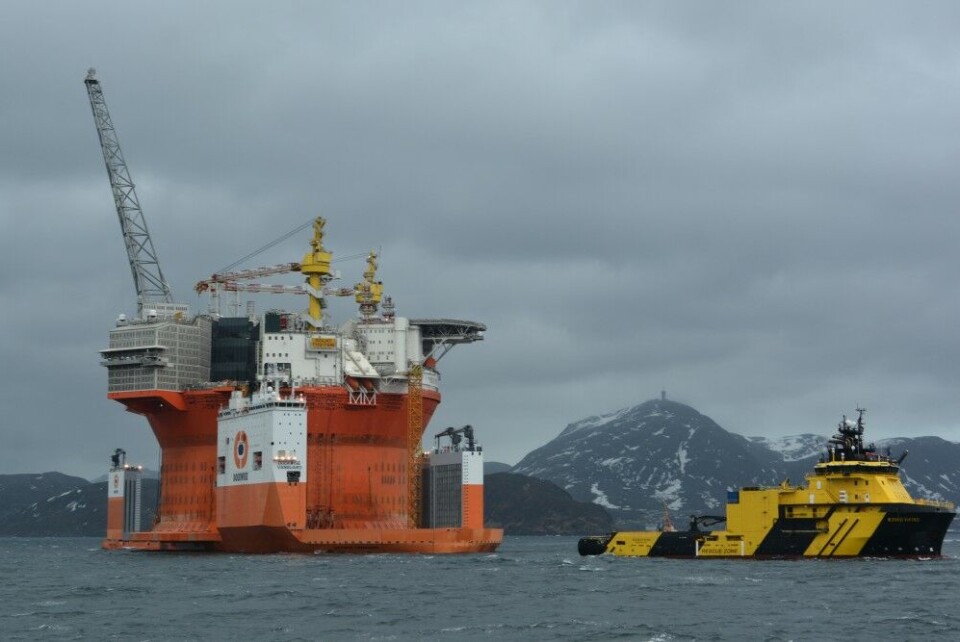
Doubts remain about Norway's ability to earn money from Arctic oil
Parliament Member fears Norway never will make money from ENI’s scandal platform in the Barents Sea that now has been shut down for two months.
p.p1 {margin: 0.0px 0.0px 0.0px 0.0px; font: 11.0px Helvetica; color: #000000; -webkit-text-stroke: #000000}p.p2 {margin: 0.0px 0.0px 0.0px 0.0px; font: 11.0px Helvetica; color: #000000; -webkit-text-stroke: #000000; min-height: 13.0px}span.s1 {font-kerning: none}
Controversies about Norway’s oil-drillings off the coast of Finnmark continue as Minister of Petroleum and Energy, Terje Søviknes, this week failed to answer questions about when the country will get a net cash flow from the Goliat oil field.
Answering a question from Parliament Member Lars Haltbrekken, Minister Søviknes said «Only after the end of production will the owners of a field be able to give the final answer to questions such as profitability of the development as a whole, the profitability for each owner-company and the overall tax effects a field has created for current owners and historic owners.»
Søviknes pointed to estimates by ENI, the operator of Goliat, expecting that the company’s income will be larger than investments- and operating costs from 2022.
78% exploration tax cut
For the state, however, the net cash flow looks different. Norway subsidizes all petroleum companies by allowing them to take off 78% from their exploration costs and deduct this from their income tax. This is done to facilitate for cheaper and more attractive exploration activities.
Goliat started operations in 2015 after a two-year costly delay and since then production has been on-off-on-off following several incidents and safety notifications from the Norwegian Petroleum watchdog. In September, production was halted for planned maintenance. Production was relaunched on October 3rd, but only a few days after the oil pumps started again, on October 5th, the Petroleum Safety Authority ordered a shut down of all production after an audit of the electrical safety on board discovered threat of ignition related to electric motors.
Norwegian business daily Dagens Næringsliv on Wednesday published a list of 53 reported «unwanted incidents» at the Goliat platform since January 1st 2016. p.p1 {margin: 0.0px 0.0px 0.0px 0.0px; font: 11.0px Helvetica; color: #000000; -webkit-text-stroke: #000000}span.s1 {font-kerning: none}During the first year of production, Goliat was shut down five times. Last incident was on Sunday, when the gas alarm was triggered on board and the crew prepared evacuation by entering the lifeboats.

No production means delayed income, for ENI and for the Norwegian Government.
p.p1 {margin: 0.0px 0.0px 0.0px 0.0px; font: 11.0px Helvetica; color: #000000; -webkit-text-stroke: #000000}span.s1 {font-kerning: none}
«Climate-bomb»
Parliament Member Lars Haltbrekken says to the Barents Observer that there are big doubts about if the field ever will make net profit for Norway.
«The Minister of Petroleum and Energy is still not answering the question about when the state will earn money on Goliat,» a field Haltbrekken names «a climate-bomb.»
«We fear Søviknes’ evasion is because the answer is that the state never will earn money,» Lars Haltbrekken says.
He calls on a change in Norway’s current taxation policies for oil exploration on the continental shelf.
«The favorable sponsorship of Arctic oil exploration through the current tax regime should be changed. Today, the state takes most of the risk,» Haltbrekken argues.
Enormous Barents Sea subsidies
p.p1 {margin: 0.0px 0.0px 20.0px 0.0px; line-height: 11.0px; font: 9.8px Arial; color: #333333; -webkit-text-stroke: #333333}span.s1 {font-kerning: none}span.s2 {text-decoration: underline ; font-kerning: none; color: #0062a0; -webkit-text-stroke: 0px #0062a0}
With 78% of the costs covered by the government in tax refund, the environmental group WWF has calculated on the cost for the Government to continue exploration of the Arctic continental shelf north of mainland Norway.
An average test drill on the Norwegian continental shelf had a price of 600 million Norwegian kroner (€68 million) in 2013 of which 500 million kroner (€57 million) then are subsidised by the state.
With five test-drills at each license, the state subsidies are then 2,3 billion kroner (€261 million), which means a total subsidy of the coming Barents Sea oil drilling with 126 billion kroner (€14,3 billion), according to calculations made by WWF Norway.
p.p1 {margin: 0.0px 0.0px 0.0px 0.0px; font: 11.0px Helvetica; color: #000000; -webkit-text-stroke: #000000}span.s1 {font-kerning: none}
Norwegian newspaper Finansavisen in August reported that oil companies so far have spent 39 billion kroner (€4,1 billion) on seismic research and explorations in the Barents Sea between 1980 and 2016. For 2017, another 8 billion kroner of exploration costs will be added to that sum, according to the newspaper.
Climate changes
p.p1 {margin: 0.0px 0.0px 0.0px 0.0px; font: 11.0px Helvetica; color: #000000; -webkit-text-stroke: #000000}p.p2 {margin: 0.0px 0.0px 0.0px 0.0px; font: 11.0px Helvetica; color: #000000; -webkit-text-stroke: #000000; min-height: 13.0px}span.s1 {font-kerning: none}
Lars Haltbrekken says Norway should not add more new oil fields in Arctic waters, pointing to Statoil’s Johan Castberg, a field located north of Goliat in the Barents Sea.
«Johan Castberg will cause huge emission of climate gas to the atmosphere, that alone is an argument not to develop the field. Climate changes are so dramatic that we can not open new fields on the Norwegian shelf. The development of Goliat also shows that it is something completely different to develop a field in the Barents Sea than at other places on the Norwegian shelf,» Haltbrekken says.
p.p1 {margin: 0.0px 0.0px 0.0px 0.0px; font: 11.0px Helvetica; color: #000000; -webkit-text-stroke: #000000}span.s1 {font-kerning: none}
In September, the Barents Observer reported that Statoil had found new solutions allowing for realising the Johan Castberg project, mulling a €6,5 billion investment into the field development.















